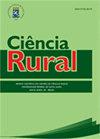Effect of thinning eucalyptus trees on soybean productivity in integrated crop-livestock-forestry systems
IF 0.9
4区 农林科学
Q3 AGRONOMY
引用次数: 2
Abstract
ABSTRACT: The aim of the study was to evaluate the effects of integrated crop-livestock-forestry (ICLF) systems and the thinning of eucalyptus trees on the agronomical performance of soybean. Treatments consisted of cultivation under: crops under full sunlight (CFS) conditions; ICLF with triple-row tree configuration (ICLFT) in which trees were submitted to selective thinning in the fifth year after planting through removal of 50% of trees while maintaining triple-row bands; and ICLF with single-row tree band configuration (ICLFS) in which the lateral rows of the triple-row tree bands were subjected to systematic thinning at the fourth year after planting. The physiological and agronomical variables of the soybean crop were evaluated at the R5 and R8 reproductive stages during the eighth harvesting season (2018/2019). Soybean sampling was carried out at five random positions in the CFS and in four transects at distances of 3, 6, 10 and 15 m from the tree bands in both the north and south faces of the ICLF systems. There were no differences between soybean grown under the ICLF and CFS systems with respect to specific leaf area, plant density, lodging index and mass of a thousand grains. However, the ICLF increased dry leaf mass and leaf area index and reduced soybean plant heights. Soybean productivity was reduced by 26% in ICLF-T and 14% in ICLF-S, that is, a 12% reduction in the productivity loss with systematic thinning. It is concluded that ICLF reduces soybean productivity in the effective grain production area of the system, regardless of the degree of thinning, although systematic thinning by removing the lateral tree lines to conversion of triple-rows into single-rows minimizes the loss of soybean grain yield.间伐桉树对农林复合系统大豆生产力的影响
摘要/ ABSTRACT摘要:本研究旨在评价作物-畜禽-林业综合系统(ICLF)和桉树间伐对大豆农艺性能的影响。处理包括:在全日照条件下种植作物;三行树构型ICLFT (ICLFT),即在种植后第5年,在保留三行带的情况下,将50%的树木砍掉,进行选择性间伐;单行树带配置(ICLFS),即在种植后第四年对三行树带的侧行进行系统间伐。在第8个收获季节(2018/2019)的R5和R8生育阶段,对大豆作物的生理和农艺变量进行了评价。在ICLF系统南北面距离树带3、6、10和15 m的4个样带中,在CFS内的5个随机位置进行大豆取样。ICLF和CFS系统下大豆的比叶面积、密度、倒伏指数和千粒重均无显著差异。但ICLF增加了大豆干叶质量和叶面积指数,降低了大豆株高。ICLF-T和ICLF-S的大豆产量分别下降了26%和14%,即系统间伐减少了12%的生产力损失。综上所述,无论间伐程度如何,ICLF都会降低系统有效粮食生产区域的大豆产量,尽管通过去除侧树行以将三行转为单行的系统间伐可以最大限度地减少大豆产量的损失。
本文章由计算机程序翻译,如有差异,请以英文原文为准。
求助全文
约1分钟内获得全文
求助全文
来源期刊

Ciencia Rural
AGRONOMY-
CiteScore
1.70
自引率
0.00%
发文量
233
审稿时长
2-4 weeks
期刊介绍:
The purpose of Ciência Rural is to publish the results of original research, note and reviews which contribute significantly to knowledge in Agricultural Sciences. Preference will be given to original articles that develop news concepts or experimental approaches and are not merely repositories of scientific data. The decison of acceptance for publication lies with the Editors and is based on the recommendations of Editorial Comission, Area Committee and/ or ad hoc reviewers. The editors and reviewers are external to the institution.
 求助内容:
求助内容: 应助结果提醒方式:
应助结果提醒方式:


